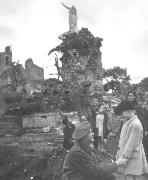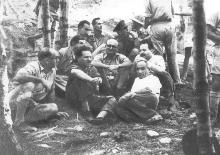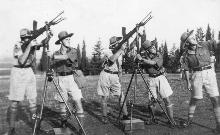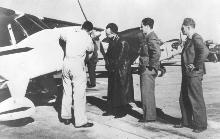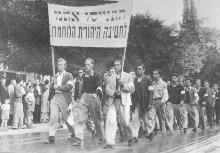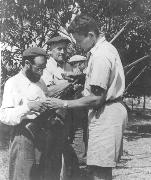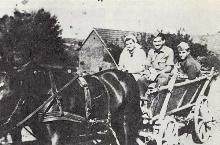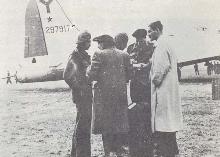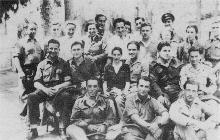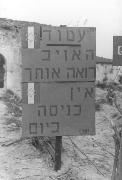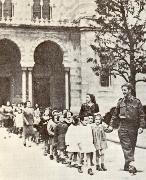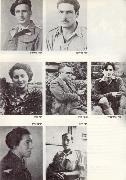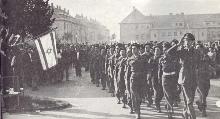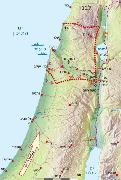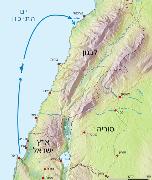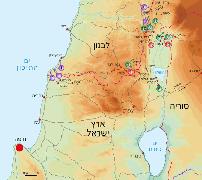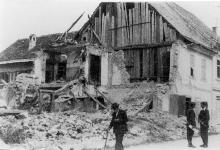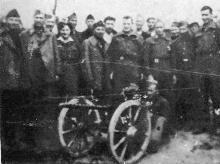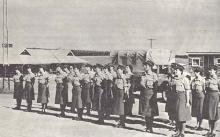| Hagana during World War II, 1939-1945 |
The Hagana's constitution stated that the organization was not accountable to a non-Jewish government. Its existence, activities and weapons must be kept strictly clandestine; those who do not abide by this rule must be held accountable. In spite of this statement, conditions during World War II led to collaboration with the British. The Yishuv leadership summoned every one fit for military service to join the allied forces in the war against the Nazis. The Yishuv responded to the summons with 30,000 Jews enlisting in the British Army. The Jewish Agency and Hagana enlisted the majority of the volunteers. They were referred to supporting units, or to serve in the platoons. Permission to establish Jewish combat units was given only in 1943 and the Chil- known as 'the Jewish Brigade in the British army' - was established only towards the end of the war. The British Army collaborated with the Yishuv according to its needs and the Yishuv's ability to satisfy those needs. For example: The British sent a Jewish force to sabotage refineries in Tripoli, Lebanon in May, 1941. The force included 23 Hagana naval course graduates, Fosh and Palmach members and one British officer. The force known as 23 Yordei Hasira (23 seamen), never reached its destination and their fate remains a mystery till this very day. The Palmach was established as a result of the threat of German invasion in the spring of 1941. At the beginning, the British participated in Palmach training and funding whose purpose was to function as a guerilla force in case of a German invasion. Plans for the Yishuv's defense were made in the event of the invasion of Palestine. The 'Northern Scam' called for the entire Yishuv to assemble on Mount Carmel and defend the country. Palmach scouts participated in the Australian invasion of Syria and Lebanon that were occupied by Pro-Nazi Vishi France. Palmach also included the German Unit operating behind German lines, and the Arab Unit that sent "Mistaarvim" (fighters camouflaged as Arabs) on intelligence and sabotage assignments in Syria and Lebanon. All the above was in collaboration with Middle East British Army H.Q. Paratroopers were sent into Europe as part of the collaboration with British military intelligence. Highly motivated volunteers from various countries in occupied Europe, speaking the required languages, enlisted in the paratroopers, whose mission was to contact Jews in occupied countries. Collaboration with the British ended once the German invasion threat was over. Even though the collaboration was limited, the contribution of the Jewish recruits was substantial: Many of the volunteers remained in Europe after the war to help the survivors. They assisted the Habricha (Escape) Organization and the Haapala- the illegal immigration to Mandatory Palestine, and helped train new immigrants. The military experience acquired by the volunteers was later passed on to the Hagana and contributed greatly during the War of Independence, and the foundation of the IDF. Volunteering to the British Army 30,000 Jewish men and women volunteered to the British army to help in the fight against the Nazis. Many of the volunteers were Hagana members permitted to join the British Army. Volunteers served in naval, air and land corps, mainly in the British Army's Jewish Brigade or in infantry, transport, armament, pioneers battalion and other units. Jewish officers were mainly Hagana members. The volunteers fought in France, Greece, the Western Desert, Italy and in the Far and Middle East. The "Brigade" (the Jewish Brigade in the British army) was established towards the end of the war and was known by its Jewish name: The Jewish Fighting brigade (Chil). Brigade men came from the Jewish Units, and had fought in the River Sanyo Battle - the final battle in which the German army collapsed in Italy. The Brigade was the only military division in the allied forces that fought as a Jewish unit with its own Jewish insignias and national flag. The Brigade commander was a British Jew, Brigadier Ernest Benjamin, who together with the Hagana's underground command dealt mainly with the holocaust survivors and with weapons purchasing. Brigade delegates marched in the victory parade in London after the war, holding their own national flag. During WW II, 680 Jewish soldiers were killed in action. Members of the British army's Jewish, and others Yishuv soldiers serving in Europe, were the first to meet with holocaust survivors, help them and transport them to the harbors from which they will reach Palestine. The 'illegal' activity included many units and soldiers, and was authorized by the Hagana. The military and organizational experience acquired during the war contributed to a greater understanding of command and mobilization of large army units, and was passed on to the Hagana and enhanced the organization and combat methods of the IDF. | |||||||||||

